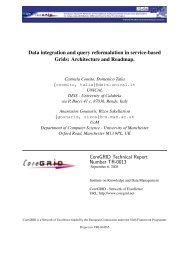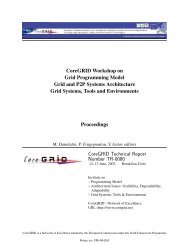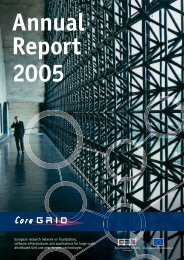24<strong>CoreGRID</strong>InstitutesOur flexibleGrid plat<strong>for</strong>m issuitable <strong>for</strong> a widerange <strong>of</strong> devices,from portablePDAs to parallelsupercomputers.Vladimir GetovLeader <strong>of</strong> the Grid Systems,Tools and Environments Institute,University <strong>of</strong> WestminsterGRID SYSTEMS, TOOLSAND ENVIRONMENTSObjectivesThe research activities <strong>of</strong> the STEInstitute are organised in four taskswith the following objectives:Generic Plat<strong>for</strong>m: This task addressesthe development <strong>of</strong> a generic,component-based plat<strong>for</strong>m, with focuson its architecture, interoperability,security, and design methodology.This plat<strong>for</strong>m is specifying the basic“glue” from which higher-levelcomponents and services can beconstructed. Challenges arise fromheterogeneous s<strong>of</strong>tware libraries,toolkits, operating systems and existingGrid frameworks. The specification <strong>of</strong>this plat<strong>for</strong>m underpins the researchareas <strong>of</strong> the other three tasks.The research activities <strong>of</strong> the Institute onGrid Systems, Tools and Environments(STE) focus on developing the designmethodology <strong>for</strong> a generic componentsystem that integrates applicationcomponents, tools/system components,problem-solving environments (PSE),portal components, and infrastructureresources components. The specification<strong>of</strong> the Institute’s generic Grid plat<strong>for</strong>msignificantly advances the state <strong>of</strong>the art. It enables the design <strong>of</strong>component-based Grid systems with asingle, seamless and “invisible” Grids<strong>of</strong>tware infrastructure. Our researchresults are equally valid <strong>for</strong> both theclient/server and the peer-to-peerparadigms. The Institute’s approachencompasses both the application <strong>of</strong> thecomponent model and its integrationinto a service-based framework.The STE Institute involves morethan 80 senior researchers and PhDstudents who participate in elevenresearch groups <strong>for</strong> implementingthe Institute’s roadmap.The STE Institute’s approach enablesthe design <strong>of</strong> reconfigurable Gridsystems with dynamic propertiesguaranteed by our componentbasedframework. Our flexible Gridplat<strong>for</strong>m is suitable <strong>for</strong> a wide range<strong>of</strong> devices, from portable PDAs toparallel supercomputers. Beyond thecontributions <strong>of</strong> the Institute partners,there exist many individual approaches<strong>for</strong> building Grid systems, tools andenvironments by other projects.The STE Institute maintains workingcontacts with key projects, proliferates<strong>CoreGRID</strong> results, and fosterscollaboration with relevant researchactivities in Europe and worldwide.The STE Institute brings togethertwelve partners – IPP-BAS, USTUTT,ICS-FORTH, IC, INRIA, SZTAKI, UWC,UNIPI, UOW, UPC, VUA, and CYFRONET– from ten different Europeancountries. In addition two newassociated partners – CATNETS andUNIVIE – joined the Institute in 2007.Mediator Components: This task isresponsible <strong>for</strong> designing a componentsuite that mediates between theapplications and system layers,providing core services according tothe architecture <strong>of</strong> the generic plat<strong>for</strong>m.These include such capabilities asdynamic application steering, metadataretrieval, and service discovery.The components delivering thesecapabilities are integrated and exposedvia a runtime environment that actsas a gateway to system components,thus addressing the integration aspects<strong>of</strong> the generic component plat<strong>for</strong>m.Integrated Toolkit: This task isspecifying and designing a toolkit<strong>for</strong> simplifying the deployment <strong>of</strong>Grid-unaware applications while alsooptimising application per<strong>for</strong>mance.More specifically, this involvesdefining and mapping applicationrequirements to the component-basedgeneric plat<strong>for</strong>m as well as providingapplication interfaces to the mediatorcomponents. The runtime environment<strong>of</strong> such an integrated toolkit is ableto run applications in a Grid and
25<strong>Annual</strong>Report2007optimise their per<strong>for</strong>mance dynamicallyin a way transparent <strong>for</strong> the user.Advanced Tools and Environments <strong>for</strong>Problem Solving: This task involvesdesigning PSEs or portals that takelegacy s<strong>of</strong>tware and automaticallydeploy it as a service that con<strong>for</strong>ms toa standard service model. The aim isto integrate our generic plat<strong>for</strong>m intoPSEs and portals allowing users tocompose, steer, monitor and visualisejob execution in a transparent andsimple way. This work is based onidentified deployment scenarios,using technologies <strong>for</strong> wrappinglegacy code and mechanisms <strong>for</strong>deploying and managing services andjobs in peer-to-peer environments.Industryadded-valueBased on the studies per<strong>for</strong>medwithin the STE Institute, the followingjoined projects have recently beenlaunched in order to implement theidentified research and developmentwork. Thus, the STE Institute continuesand expands its research usingthe prototype Grid systems underdevelopment by these projects:• GridCOMP – building anadvanced component plat<strong>for</strong>m<strong>for</strong> an effective invisible Grid.• XtreemOS – designing a Linuxbasedoperating system tosupport virtual organisations<strong>for</strong> next generation Grids.• EDGeS – creating a Gridinfrastructure that seamlesslyintegrates a variety <strong>of</strong> desktop Gridswith production service Grids.Those spin-<strong>of</strong>f projects have beenthe main vehicle <strong>for</strong> applying theimpact <strong>of</strong> the Institute’s researchactivities in industrial environmentswith direct contribution to improvingthe European economy in the area<strong>of</strong> Grid and service technologies. Inaddition, the STE Institute has beeninvolved in the development <strong>of</strong> fullscaleuse cases in collaboration withindustrial partners via the currentlyactive spin-<strong>of</strong>f projects. Our industrialpartners <strong>for</strong> this activity include AtosOrigin, Grid Systems, and IBM.Challenges andperspectivesCurrently, the STE Institute isaddressing the following problemsand scientific challenges:• The combination <strong>of</strong> applicationsand system s<strong>of</strong>tware to integrateds<strong>of</strong>tware assemblies is a centralproblem we are addressing. Theaim <strong>of</strong> this integration is tw<strong>of</strong>old:(1) to allow applications to better andmore flexibly use Grid resources, and(2) to enable system servicesto effectively steer andcontrol their applications.For this purpose, we are designingand building an integratedcomponent system that has asingle glue layer between all<strong>for</strong>ms <strong>of</strong> components. Thus most<strong>of</strong> the complexity <strong>of</strong> integratingthe many individual s<strong>of</strong>twareitems will be removed.• The development <strong>of</strong> applicationsto be run on the Grid is stilldifficult, preventing the widespreadadoption from non-expertusers. The challenge in thiscase is to provide developmentand execution environments<strong>for</strong> Grid-unaware applications,where the Grid resources canbe transparently exploited.• Finally, applications typically haveto be adapted to run on specifichardware plat<strong>for</strong>ms. For improvingper<strong>for</strong>mance, the applications haveto be specifically tuned <strong>for</strong> eachhardware plat<strong>for</strong>m. This situationis not feasible in Grid computingenvironments, since the executionplat<strong>for</strong>m can change on a per-jobbasis, and even at run time. Inthese kinds <strong>of</strong> environments, theapplications have to adapt to thesystems and resources available.By now, the STE Institute has reachedthe roadmap phase <strong>of</strong> ongoing,integrated research, mostly fosteredby joint projects, such as GridCOMP,XtreemOS, and EDGeS. Havingreached this critical mass <strong>of</strong> ongoingresearch activity, our future stepsfocus on achieving sustainability aspart <strong>of</strong> the <strong>CoreGRID</strong> network by:• Coordinating activities <strong>for</strong> Institutepartners’ participation in nationaland international research as wellas industrial projects related to Gridsystems, tools, and environments,assuming the results <strong>of</strong> thisInstitute as starting points to ensurestable and durable cooperation.• Organisation <strong>of</strong> an annual workshopto discuss and present newdevelopments in the area <strong>of</strong> Gridsystems, tools, and environments.• Maintenance and update <strong>of</strong> theexisting Institute web site withthe aim to have a permanent<strong>for</strong>um durably hosting in<strong>for</strong>mationon European research activitiesrelated to Grid systems, tools,and environments, where theannual workshop will alsobe linked in prominently.• Active participation and support<strong>for</strong> the sustainability activities at<strong>CoreGRID</strong> level including continuouscollaboration with other <strong>CoreGRID</strong>Institutes and constructive contactswith <strong>CoreGRID</strong> industrial partners.








